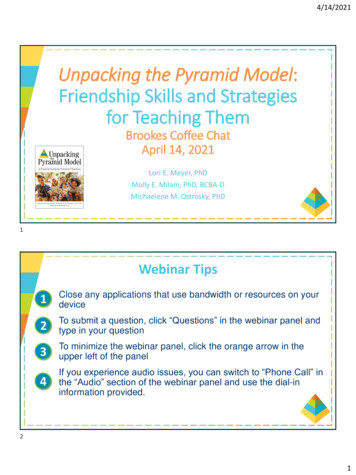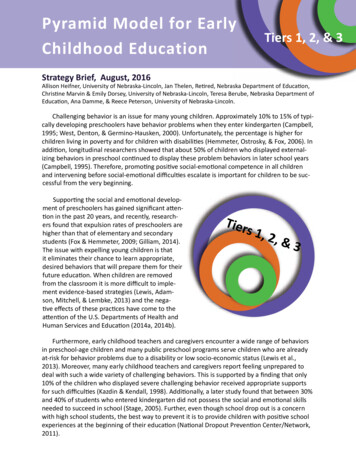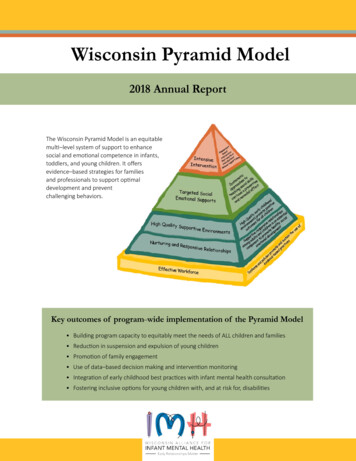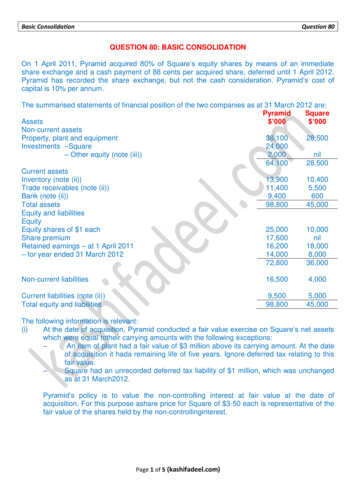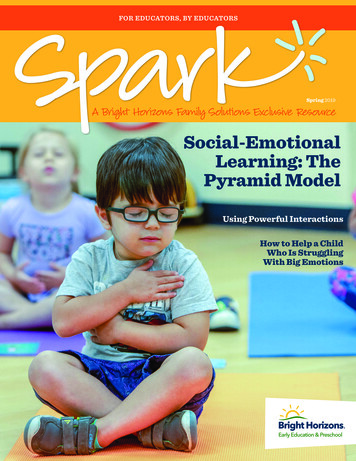
Transcription
FOR EDUCATORS, BY EDUCATORSSpring 2019A Bright Horizons Family Solutions Exclusive ResourceSocial-EmotionalLearning: ThePyramid ModelUsing Powerful InteractionsHow to Help a ChildWho Is StrugglingWith Big Emotions
From Playdates to the Board Room:SEL Skills for LifeWhen my daughter Hanna was about 8,I found her in her backyard playhousewith a friend. They were sitting in twochild-sized Adirondack chairs with someyarn. I asked what they were up to and mydaughter replied, “Knitting for charity.” Itwas such an unexpected answer, and I wasboth touched and proud. Fast-forward morethan a decade, and I can look back at thatmemory and understand the slew of socialemotional skills that she was drawing on:perspective-taking, empathy, emotionalrecognition, and so on.Most parents can think of tender momentswhen their baby laughed, their toddler had her first play date, or their child did something kind foranother person. We think of these moments as sweet and touching, but we often don’t recognize themfor the significant developmental milestones they signify. Like learning to walk or learning to read, thesesocial-emotional competencies develop over time, step by step, based on children’s developing abilitiesand caregiver support.At this point, the evidence is fairly conclusive — social-emotional development and learning (SEL) arecritical for school and life success and satisfaction. If we want children to do well and be happy, thesecompetencies are the key. Further, understanding the path of social-emotional development is crucial.Too often, we have inappropriate expectations for young children, such as expecting them to managedisappointment easily or share all the time. Let’s face it: We can’t even do this consistently as adults.And we miss opportunities to intentionally teach and scaffold this development every day. From themoment a child steps (or crawls or is carried) into a classroom, there are plentiful opportunities to buildnurturing and secure relationships — the foundation of all development and what we call Prime Timesat Bright Horizons — and help them develop age-appropriate social skills, learn about emotions,and discover how to handle them. When all of this is happening, challenging behaviors are drasticallyreduced!The importance of social-emotional skills and the companion set of self-regulation skills cannot be overstated. They are the not-so-secret ingredient behind every successful child and adult. In the pages of thisedition of Spark, you will learn more about typical social-emotional development, gather ideas for dailydevelopment, and expand your knowledge of ways to respond to challenges that teach new skills. Eachchild deserves our collective commitment to continually improve our teaching skills. Bonus: You mighteven learn a trick or two to apply in your own life.Your partner in teaching and learning,Rachel RobertsonVP, Education and DevelopmentFollow Rachel on Facebook@RachelRobertsonBH Spark, a BH Exclusive Resource – Social-Emotional Learning – Spring 2019 2 Issue
TheBenefits of Focusing onSocial-emotional Learning“Teachers often report feeling ill-equipped to meet theneeds of children with challenging behavior and frustratedin their attempts to develop safe and nurturing classroomenvironments. These teachers spend much of their timeaddressing the behaviors of a few children, leaving little time tosupport the development and learning of the other children.Increasing evidence suggests that an effective approach toaddressing problem behavior is the adoption of a model thatfocuses on promoting social-emotional development, providingsupport for children’s appropriate behavior, and preventingchallenging behavior (1).”Social-emotional Skills for AdultsWe know social-emotional development is important, but what is it exactly? It’s helpful tofirst think about all the social-emotional skills adults need to function successfully in life,such as the ability to:f Recognize, identify, understand, and manage our emotional states.f Understand, empathize with, or accept another’s point of view (theory of mind).f Form attachments to significant people in our lives, make friends, and nurture and care forone another.f Use reason and logic to make decisions.f Delay gratification, e.g., wait to buy something until we can afford it.f Follow rules established for health, safety, and the common good.f Contribute to society in productive ways.f Set healthy boundaries for our well-being and the well-being of those around us. Wedon’t run over others and we don’t allow others to run over us. We respect ourselves andeveryone else.f Solve conflict through self-reflection, dialogue, and compromise.It’s fairly obvious that without these skills, adults will have difficulty in their collegeexperiences, careers, relationships, and life, but these skills don’t develop overnight. Theygrow through many years and their foundation starts in early childhood. Spark,a BHExclusiveResource– Social-EmotionalLearning– Spring2019 2Issue Spark,a BHExclusiveResource– Social-EmotionalLearning– Spring2019 2Issue
The Pyramid Model:A Targeted ApproachIn this issue, you’ll read a lot about children’s healthy social-emotional development asa primary goal at Bright Horizons, and you’ll learn about CSEFEL’s Pyramid Model, asimple, effective approach to nurturing social-emotional growth.CSEFEL and the Pyramid ModelThe Center on the Social and Emotional Foundations for Early Learning (CSEFEL) at Vanderbilt Universitydeveloped the Pyramid Model to describe a simple, yet profoundly effective, framework for addressing socialemotional learning. The framework relies on four levels of teaching practice to support children, even thosewith persistent behavioral challenges, in a classroom setting:According to CSEFEL, “when theThis issue of Spark focusesthreelower levels of the pyramid areon the social-emotionalin place, only about four percent of theaspects of the Pyramidchildren in a classroom or program willIntensiverequire more intensive supportModel — targetingindividualized(Sugai et al. 2000).” This knowledge islevels two, three,empowering because it givesinterventionsand four* whichteachers the keys to makepositive change.are related toTargeted socialsocial-emotionalemotional supportsdevelopment.High qualitysupportive environmentsNurturing and responsive relationshipsTeacher knowledge of children’s development Spark, Spark,a BH ExclusiveResource– Social-EmotionalLearningLearning– Spring– 2019 2Issue Issuea BH ExclusiveResource– Social-EmotionalSpring 2019 2*The fifthlevel, intensiveintervention, isbeyond the scopeof this magazine.Please see CaringMatters for moreinformation.
Why It Matters:Long-Term EffectsSocial-emotional development sometimes takes a backseat as teachers feel pressure to offermore “academic” learning. But social-emotional learning is the foundation that allows forsuccess in all other areas of life.All of the components of SEL learning are critical for later success in school, life, and relationships. Inone of the most comprehensive studies to date, researchers reviewed 213 studies detailing the effects ofSEL programs. They discovered that (at-risk) students participating in SEL programs had:f An 11 percentile point gain in academic performance over those students who did not participatein an SEL program.f Better attitudes about themselves, each other, and school.f Improved behavior.f Increased ability to handle life challenges and stress (2).Several other studies have found that children who participate in SEL programs are less likely as adultsto engage in risky behavior, require public assistance, be arrested for violent acts, or have veLearningoflReferences: 1. Fox, Lisa, et al. “The Teaching Pyramid: A Model for Promoting Social Competence and Preventing Challenging Behavior in Young Children.” July, 2003. Young Children.Washington, D.C.: NAEYC. Retrieved at 4/4.7.pdf 2. Gunn, Jennifer. “The Real and Lasting Impacts of Social-Emotional Learning WithAt-Risk Students.” July 25, 2018. Concordia University Portland. Retrieved at esources/sel-at-risk-students/a BH ExclusiveResource– Social-EmotionalSpring 2019 2 Spark, Spark,a BH ExclusiveResource– Social-EmotionalLearningLearning– Spring– 2019 2Issue Issue
Social-Emotional Development:A ContinuumThink about how an infant develops physically. Young babies first lift their heads, rollover, and then sit up. Later, they gain control of their limbs — grabbing toys, picking up food,crawling, and finally walking. All this happens within the first 12 to 14 months of life for mostchildren — a remarkably brief period of time. The process unfolds in a gentle, gradual sequence.Social-emotional skills emerge in a similarly predictable fashion, but they’re harder to see — andperhaps harder to understand. We sometimes expect young children to do more than they’rerealistically able. But as educators, we must understand social-emotional development and knowhow to nurture it.This chart outlines some other areas of social-emotional development.One Example: How Friendships DevelopAG E G ROU PInfantToddlerPreschoolersSchool-AgeChildrenW HAT F R I E N DS H I PSLO O K L I K EShow interest in peers.H OW W E CA N H EL PRespond to children quickly.Build trust and security.Play side-by-side, not collaboratively.Play games, laugh, and enjoy timetogether.Moving toward collaborative play.Model back-and-forth conversation.Don’t share materials or take turnsconversationally.Show interest in children’sthoughts and feelings.Can share materials.Demonstrate back-and-forth play.Can take turns in conversation.Model sharing. Encouragecollaborative work.Beginning to empathize.Offer help in resolving conflict.Can collaborate and extend play.Model and have discussions aboutconversational turn-taking, showingempathy, and resolving conflict.Understand concepts of fairness.Can create games with rules.Can relate to another’s perspective.Offer opportunities forcollaborative play. Spark, Spark,a BH aExclusiveBH ExclusiveResourceResource– Social-Emotional– Social-EmotionalLearningLearning– Spring– Spring2019 22019 2Issue Issue
Social-Emotional DevelopmentBy AgeConsider ways that you might support children in each area. As you read the magazine,watch for other ideas and refer back to this chart.INFA NTExpresses a variety of emotions.TO DDL E RShows interest in another child’s emotions.Begins to learn about sharing.Responds to the cries of other infantsby crying themselves.Responds with empathy to a child whois sad or hurt.Responds with pleasure to nurturing care.Sees others as distinct and separate.P RE S CHO O LS C H O O L AG ERecognizes and names emotions.Understands that another child can feel differentlythan they do.Values fairness.Looks to adults to know how to handle situations.Can consider another’s perspective.Comforts friends in distress.Understands abstract concepts.Uses black-and-white thinking, but beginningto understand others’ perspectives.Shares with peers.Shows more self-control overemotional reactions.Uses role-playing to learn about emotions.Responds to guidance. Spark, aa BHBH ExclusiveExclusive ResourceResource –– Social-EmotionalSocial-Emotional LearningLearning –– SpringSpring 2019 22019 2 IssueIssue Spark,
Understanding and Responding toChildren’s CommunicationMany of us grew up with the notion that children’s behavior is something to be managed andcontrolled, often through a system of rewards and punishments. When children are “good,” theyare given a reward or treat; when they’re “bad,” they face time out, loss of privileges, or a similarconsequence.These ideas might help us “manage” behavior in the short-term, but they can have long-termnegative effects. What if, instead, we looked at behavior from a different perspective — as a means ofcommunication? How would that change our interactions with children?Behavior is children’s primary way of communicating, especially during the early years when theyare still developing language. When we understand this, we can respond to children empathetically,in ways that build relationships and trust. Psychologists, educators, and behavioral specialists havediscovered that behavior is most often communicating one (or more) of the following:I do not understand your expectation.When children are confused, it’s hard for them to listen or follow directions.They might seem uncooperative, when, in fact, they are likely feeling frustratedor anxious. Most children want to please adults. They want their days to runsmoothly and they want to feel peace, just as we do.How to help:f Create a predictable, yet flexible, routine.f Refer to a visual schedule every day; go back to it several times each day.f Make clear, realistic class rules and expectations, preferably with the children’s help. It could be as simpleas, “We care for ourselves, each other, and our classroom.” Refer back to these rules frequently.f Get on children’s level. Look them in the eye, state your expectation clearly, and explain why you have theexpectation, e.g., “When we push in line, someone can get hurt. I need you to walk carefully and keep yourhands away from other children.”f Tell children what you want them to do, rather than what you don’t want them to do. “Please walk” isclearer and more positive than “Don’t run.” Spark, a BH Exclusive Resource – Social-Emotional Learning – Spring 2019 2 Issue Spark, a BH Exclusive Resource – Social-Emotional Learning – Spring 2019 2 Issue
I cannot comply with your expectation.We wouldn’t expect a child with no musical experience to sit down ata piano and play a concerto, yet we often expect children to performsocially and emotionally in ways that they simply can’t.How to help:f Make sure your expectations are realistic (refer to the developmental milestone chart on page 6).f Recognize that each child develops at his or her own pace. The milestone chart is a general guide only.f Observe children with curiosity. Does their behavior indicate that you might be asking too much orthat they need instruction?f Limit the time children spend in group time and transitions. Use small groups over large groupswhenever possible.f Teach skills and scaffold growth, using concrete examples, visuals, and modeling. To teach a childto take turns, demonstrate by using puppets or stories. Model it yourself and then have the childrentry. Children can learn a variety of social skills, such as taking turns conversationally, sharingmaterials, joining a group, asking questions, or offering compliments with this method (see moreideas on page 19).I am feeling distress or discomfort.Children come to our programs each day with a variety of needs andexperiences. Like us, they might be hungry or tired. They might have hada busy morning or be recovering from illness. Many children’s nervous systems are sensitiveto the environment. Fluorescent lights, noise, crowds, and the energy in the room affect them.Additionally, young children are still developing self-regulation. They might be able to comply withan expectation for a little while before running out of steam.How to help:f Recognize children who are experiencing sensory overload, which often manifests itself inwithdrawal, overactivity, aggression, or stimming (repetitive verbalizations or hand gestures). Somechildren become louder and more physical; others retreat or even put their hands over their ears.f Offer quiet spaces in your classroom (learn more on page 14).f Ensure children get plenty of physical activity, especially time outdoors.f Bring natural objects inside.f Use gentle touch and a gentle voice to offer comfort.References: Gartrell, Dan. A Guidance Approach for the Encouraging Classroom. Belmont, CA: Wadsworth Publishing, 2012. Kranowitz, Carol. The Out of Sync Child. New York: TarcherPerigee, 2006.Siegel, Daniel. The Whole-Brain Child. New York: Bantam Books, 2012. Spark, Spark, aa BHBH ExclusiveExclusive ResourceResource –– Social-EmotionalSocial-Emotional LearningLearning –– SpringSpring 2019 22019 2 IssueIssue
THE PYRAMID MODEL TIER THREE: HIGH QUALITY SUPPORTIVE ENVIRONMENTSIn the next few pages, you’ll learn simple preventativeclassroom practices, which can reduce frustrationfor both teachers and children and increase socialemotional growth:fCreating an Encouraging ClassroomfUsing Words With IntentionfPracticing Mindfulness and Self-CareCreating anIntensiveindividualizedinterventionsTargeted socialemotional supportsHigh qualitysupportive environmentsNurturing and responsive relationshipsTeacher knowledge of children’s developmentEncouraging ClassroomImagine you’re invited to a friend’shome for lunch. When you arrive,your friend greets you warmly andinvites you in. The table is laidwith pretty dishes, and the food issimply, but thoughtfully, prepared.Your friend is obviously excited tosee you and you enjoy an engagingconversation as you eat.Now imagine a different experience:you arrive for lunch and your friendseems frantic and distracted. Thekitchen is a mess and the dishesand food are hastily thrown on thetable. Your friend seems relievedwhen you depart. How does the firstexperience make you feel? Valued,welcome, relaxed? How about thesecond experience? Spark, aa BHBH ExclusiveExclusive ResourceResource –– Social-EmotionalSocial-Emotional LearningLearning –– SpringSpring 2019 22019 2 IssueIssue Spark,
Creating theEncouraging ClassroomDan Gartrell (2010) frequently uses theterm “encouraging classroom” to describe aclassroom in which everyone feels valued,accepted, and welcome. Creating anencouraging classroom starts with teachers’attitudes and values, but it also includes thephysical design of the room. Think againabout the idea of preparing a meal for a dearfriend as you consider the message yourclassroom sends to children and families.Listed here are a fewideas for setting up “yes”environments that nurturesocial-emotional growth.Design a space that feels peacefuland beautiful to you. When teachersare comfortable and happy, children arelikely to be too.Simplify. Organize the materials so they’reeasy to maintain. The children should knowexactly how to use them and clean them up.Consider all the ways to set up the environmentso that it is as engaging and interesting aspossible for children and challenges them tobecome fully involved in learning with others.Set up a positive “yes” environment sothat you spend the majority of your timesaying “yes” and encouraging childrenrather than discouraging them. In otherwords, organize your space so you can say “yes”to children’s activities and ideas, instead ofno. How you arrange the furniture, how youorganize materials, and even the lighting in theroom can impact how your classroom “feels.”Limit visual clutter, especial y onthe walls, which can cause sensoryoverload. Think about keeping twice as muchof the walls blank as covered. Be thoughtfulabout what you do display. Does it make senseto the children? Does it add value? Spark, Spark,a BHa BHExclusiveExclusiveResourceResource– Social-Emotional– Social-EmotionalLearningLearning– Spring– Spring2019 22019 2IssueIssue
success in all other areas of life. All of the components of SEL learning are critical for later success in school, life, and relationships. In one of the most comprehensive studies to date, researchers reviewed 213 studies detailing the effects of SEL programs. They discovered that (at-risk) students participating in SEL programs had:







